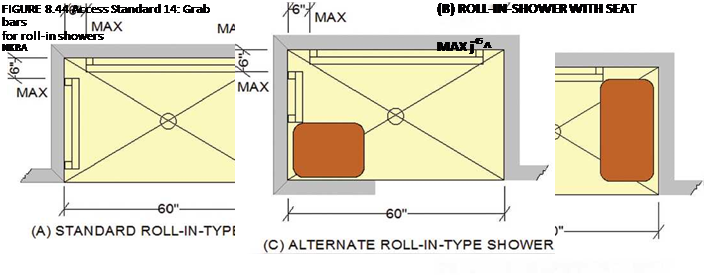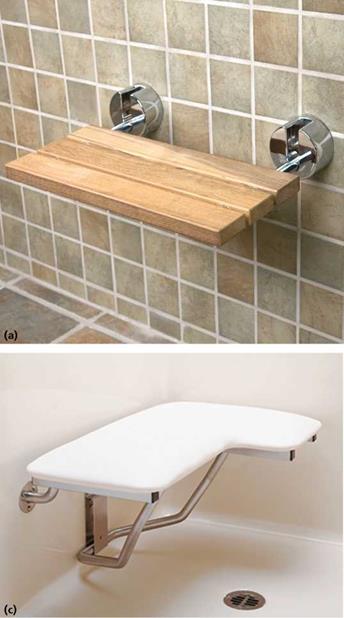Plan for the option of sitting in the shower and when entering and/or bathing in the tub. This can be done with an integrated design or as an added product, and there are guidelines for the planning and specification of the seat or surface.
Whether in a shower or tub, the recommended depth of the built-in seat is a minimum of 15 inches (381 mm), and a maximum of 16 inches (406 mm), with a preferred height of 17 inches

to 19 inches (432 mm to 483 mm), and it should gently slope toward the tub or shower base at not more than 1/4 inch per 12 inches (6 mm per 305 mm) to avoid standing water.
The deck of a drop-in, or preferably an undermount tub, can serve as a transfer seat for many. The tub deck surface needs to support a minimum load of 250 pounds (113 kg). If the tub is undermounted, the surface deck should overlap the tub flange to eliminate a permeable seam, again sloped slightly toward the tub.
When there is no room for a built-in transfer surface at the tub or shower, a removable seat can be used (see Figure 8.45). Separate bathtub and shower seats provide flexibility, but require storage space when not in use. Care must be given to ensure the stability of the seat. Fold-up shower seats do not interfere with the clear space of the shower when they are closed, and are desirable for those who wish to sit for part or all of a shower. When specifying or designing custom seats, plan for a user to put their feet under the seat for better leverage. Other features to consider in specifying the seat include a surface that is smooth for transfer and slots or an opening to provide for personal hygiene.
If using a shower curtain, the rod must extend over the seat, and a custom curtain (extra wide) or double curtains may be required. There are seats made with a slot to accommodate the shower curtain and an extension that can improve transfer.
As mentioned earlier, portable or ceiling-mounted lifting devices specified and installed by medical equipment professionals can be used to lower and lift a person in and out of the bathtub (see
 (b)
(b)
FIGURE 8.45 These seats are both flexible and solid In that they either fold-up out of the way or can be removed when not in use, but are attached securely to a wall support.
A and B courtesy of Signature Hardware Whittington Collection;
C and D Hewi from Hafele

|
|
|
|
|

Figure 8.46). The space plan will need to accommodate the function of the lift and its storage when not in use. Structural adaptation for the lift may be required.



